 Lentinellus - click to expand
Lentinellus - click to expand
This family has a genus of gilled mushrooms, less common than
Russula and Lactarius in the core Russulaceae family of the
Russulales. They are an oyster style mushroom, growing on wood
with white spores, with their most distinctive character being serrated
gill edges when mature. They are not all monomitic, as some have skeletel
hyphae making them tougher than the average gilled mushroom (like polypores).
They are most easily mistaken for
Neolentinus,
also with serrated gill edges, and also on wood with white spores, which
usually have more central and/or thicker fleshed stems, in the order
Gloeophyllales which also contains some dark fleshed polypores.
- stems absent or eccentric or fused together, otherwise thin
and cartilaginous and seldom more than 5 mm thick (unlike Neolentinus).
- Always a boring shade of brown.
The species are told apart by size (caps usually <3 cm vs.
~10 cm), whether or not there is a stem and if those stems all
fuse together.
Species mentioned: Lentinellus
occidentalis, subargillaceus, flabelliformis, micheneri, cochleatus,
umbilicatus, vulpinus, montanus, ursinus, castoreus
These small
species (<3 cm across) either have no stem or a very short, stubby
lateral stem. They are not sister species and differ microscopically.
Lentinellus occidentalis
WA - we have the type
sequence, so we know what it is. Its ITS DNA is very similar to other
species from different parts of the world, for instance the much older name
Lentinellus
novae-zelandiae. There may only be a single nucleotide that is
reliably different between the two, but for now the morphological differences
seem real and the two are not synonymized.
Lentinellus subargillaceus
OR - has slightly larger spores (up to 7u vs. 6.2u long but
the same width <4.5u) and some cystidia types are shaped differently. We have a CA sequence
from Ron Petersen and Karen Hughes, who are the people who placed this species
(formerly in Claudopus) in Lentinellus , and are the living
authorities for recognizing the species, so I trust the sequence even though we
don't have a type sequence.
Lentinellus flabelliformis EU - Ron and Karen note that reports of
this EU species in the PNW often turned out to be L. subargillaceus. No
confirmed reports have been made since 2004 when the latter species was
recombined, and its DNA has never been found in the PNW, so I tend to think that
ALL reports of this locally are really something different. If you think you
find it, sequence it and help determine once and for all if this species is
found here, as we do have EU DNA to compare to. One complication is that this
species has been reported with a substantial stem (correctly or not, I don't
know) and some even considered it a synonym of the longer stemmed L.
micheneri and L. tridentinus, below, but that is now known to be
false.
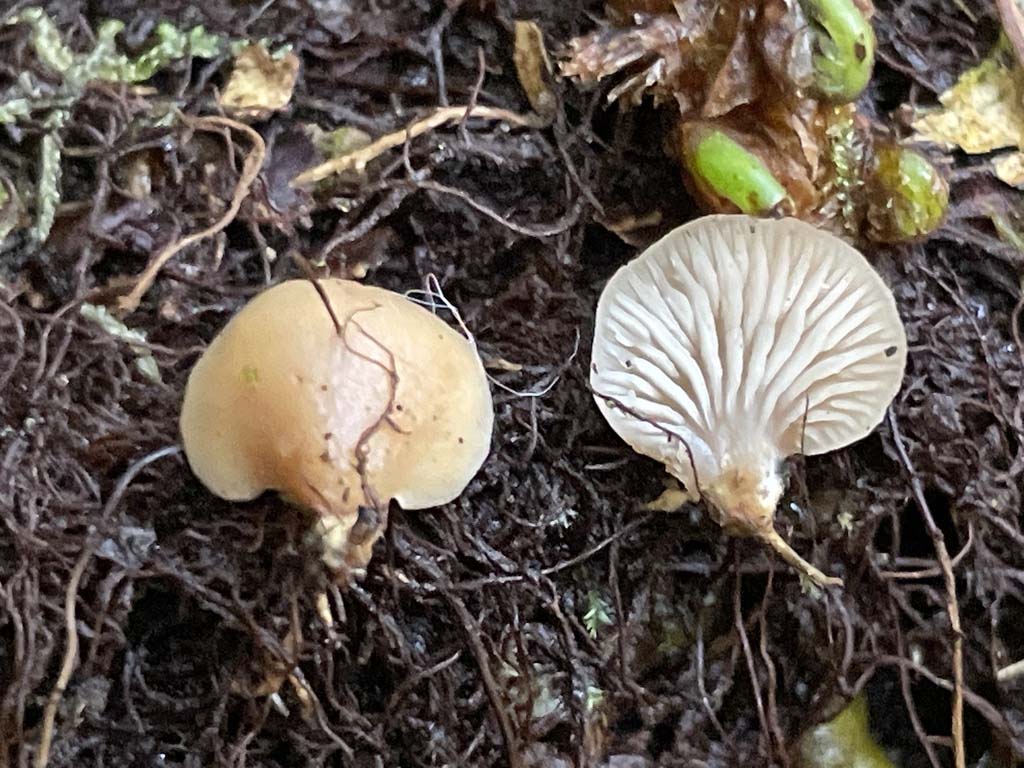
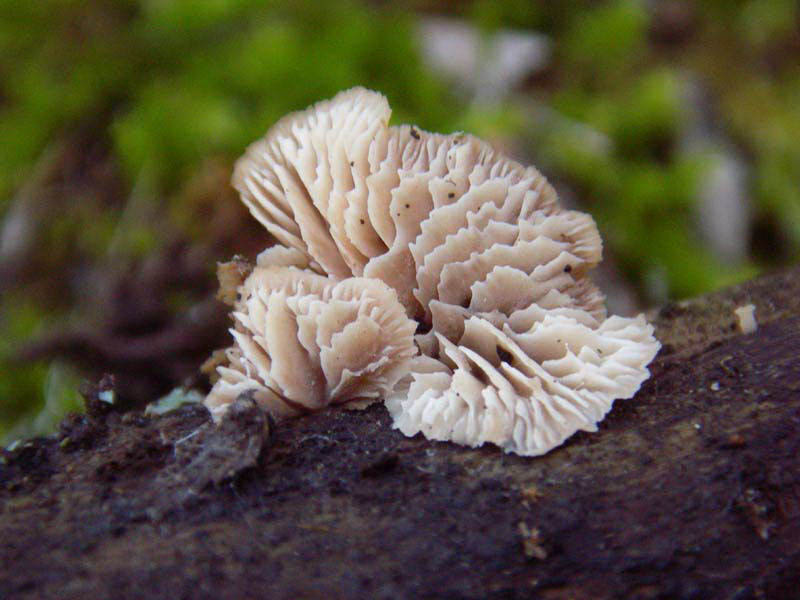
young Lentinellus occidentalis (gill edges entire) © Yi-Min Wang,
unsequenced L. occidentalis/subargillaceus group member © A and O Ceska
Small species (caps <5 cm across) with long, relatively ordinary
stems
Lentinellus micheneri PA - A small species (<5 cm across) with
somewhat distant gills and a fully formed central to
off-centre stem that is thin and cartilaginous. Bitter/peppery tasting. This eastern NA
species is found out here and in Europe as well, as the DNA appears to match
everywhere. Neolentinus kauffmanii
is very similar but has closer gills and a slightly thicker stem. We need
photographed sequenced collections.
Lentinellus cystidiosus NM
- a lookalike not expected in the PNW until two sequences from ID of supposed
L. micheneri turned out to be this. We're still looking for proof that L.
micheneri also occurs here.
Lentinellus 'tridentinus PNW01'
- with gills more distant and thicker than L. cystidiosus.
Some young collections have
strikingly coarse serrations on the gill edges even in youth, but this is not
always the case. Some have synonymized L. micheneri and L.
tridentinus
(along with L. flabelliformis above), but they are all quite obviously distinct in their DNA,
and not all close relatives of each other. L. tridentinus was not suspected from the PNW until
DNA showed up in WA 3% different than L. tridentinus of Europe. That
species is a complex in the EU with DNA varying by a percent or two, but our
sequence is 3% different than any of them and seems to sit quite clearly
separate, so it may be in need of a new name.


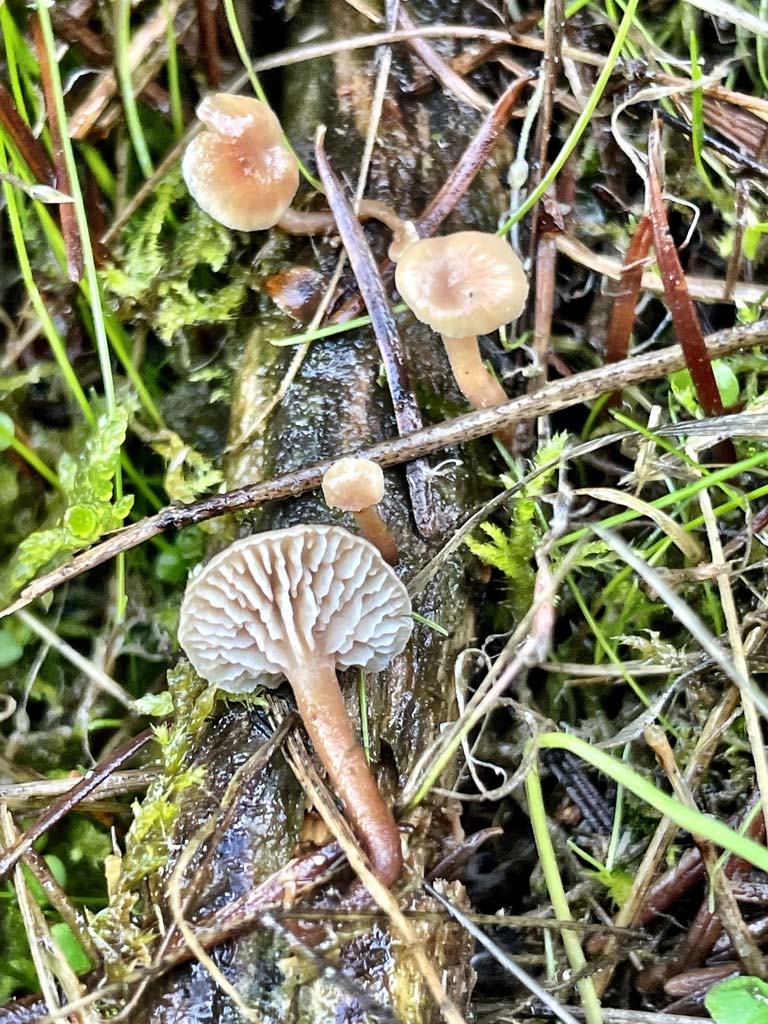
Lentinellus cystidiosus © Ed Barge, Lentinellus
'tridentinus PNW01' © Lauren Ré and Yi-Min Wang
Lentinellus 'cochleatus PNW02'
- This small species
(<5 cm across) grows in clusters with the long, thin stems fused
together. The caps may be cleft (cochleate). The other clustered species
are larger and don't have long stems. Reportedly only on
hardwoods. This is a complex of species. There are two sister species in Europe and
one in eastern North America (perhaps Lentinellus umbilicatus
NY). Our one WA sequence is none of the above and being >3% different from
the others, probably needs a new name. I wonder if we might have more than one
species here. We could sequence a strongly cleft collection, if we can find one,
to see if it's different.
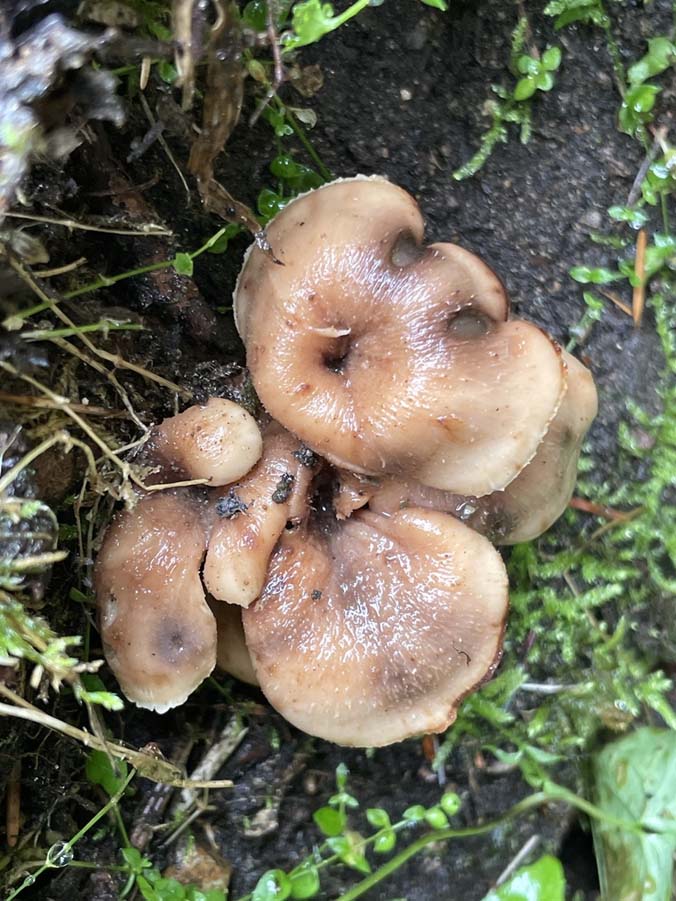

Lentinellus 'cochleatus PNW02' © Yi-Min Wang
Lentinellus vulpinus EU
- This large hardwood
species (up to 10 cm across) has small, stubby eccentric stems (if any) that are fused
together, growing as a tight imbricate clump. It tastes hot and spicy. Petersen found it to be a complex in Europe and North America with some
sequences even in Europe differing by up to 7 bp and 2 indels, (most differences
are found in ITS2) but with no ecological or morphological differences noted,
they are all assumed to be the same species. We have sequences from ID and WA.

unsequenced Lentinellus vulpinus © Kit Scates Barnhart
Lentinellus montanus ID - This
larger
species (up to 10 cm across) is stemless but has tan fuzz at the point
of attachment (no part of the underside should be without gills, so it's not
a true stem) and grows at high elevations in the
spring near snowmelt on conifers. It may taste peppery.
It was described from Idaho and is more common inland, there and in Montana.
We don't have a type sequence, but we have reliable sequences from OK Miller,
the original collector and describer, as well as a modern EWA collection. Interestingly, it is more closely related
to the smaller species than it is to its lookalike, L. ursinus. It is
monomitic, like the smaller species, which means it's not as tough fleshed as
the other large species. These microscopic textural differences are more
important phylogenetically than size.
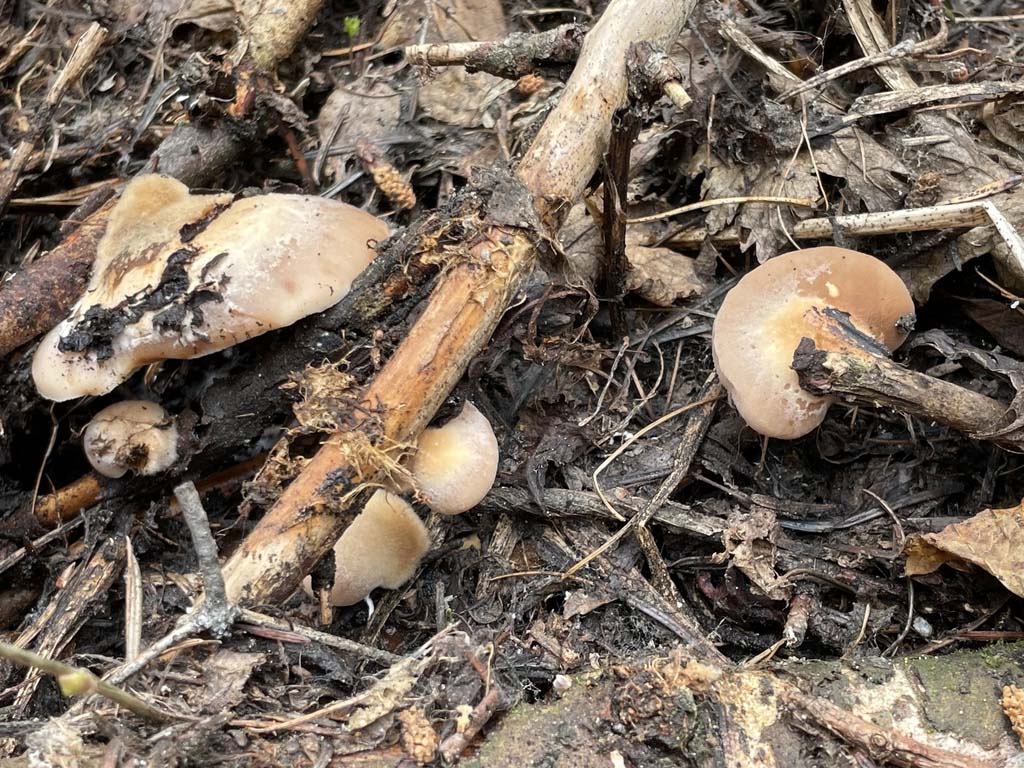
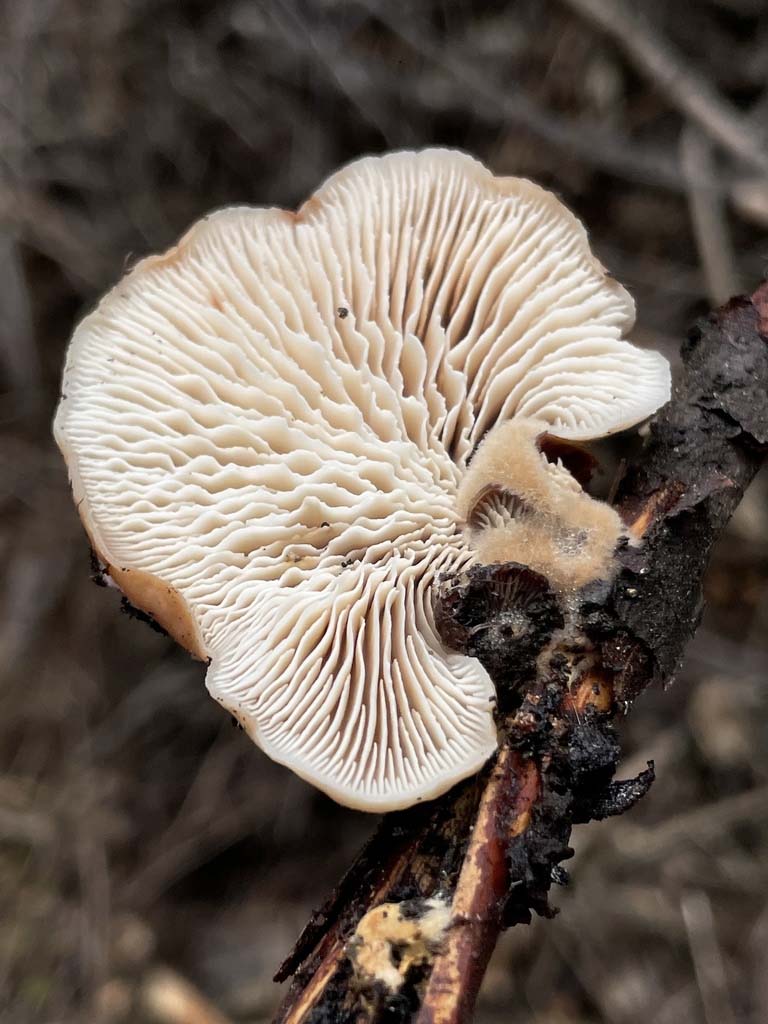
Lentinellus montanus © Yi-Min Wang (2 images)
These very similar
larger (3-8 cm across) species are also usually stemless but usually
grow in fall. Unlike L. vulpinus, they do not grow in very
tight clusters. They differ a bit by taste, shape and microscopically.
They have been confused with each other in the past, so until a type is selected
and sequenced, we will not know for certain that we have sorted out what these
sequences are.
Lentinellus ursinus EU
- a very spicy tasting conifer and hardwood European species with lots of sequences,
most of which match very well to our own sequences (and the rest within a % or
so), so I believe this species does occur here. Our two verified sequences with
tree association noted were on conifer. Sequenced from ID, WA and OR.
Lentinellus castoreus EU
- a usually a mild tasting hardwood
species, microscopically different. California sequences are 2% different than
Europe, so it's possible that the PNW has an unnamed sister species, if it is
found here, but Ron Petersen didn't note any ecological or morphological differences
between the continents and for now it's assumed to be all one species. Ron
did report it once from WA, so it probably does occur here.

Lentinellus ursinus © Steve Ness
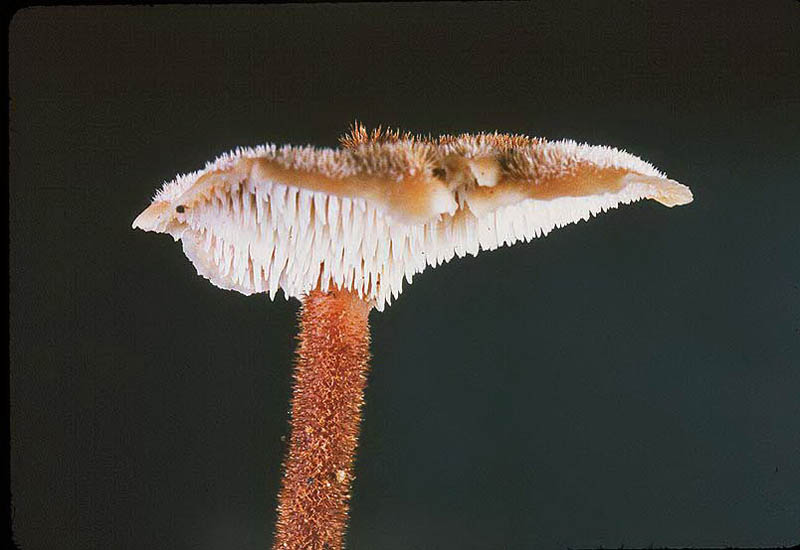
 Lentinellus - click to expand
Lentinellus - click to expand